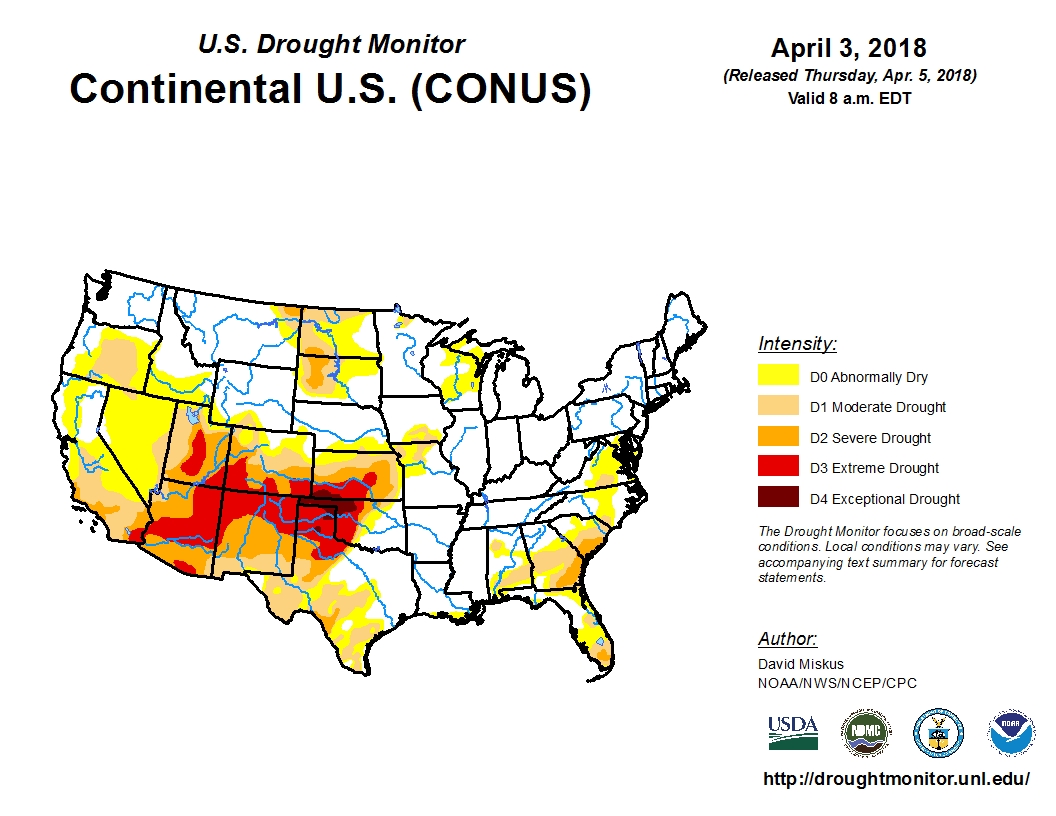
ST. GEORGE – Though there was some rain and snowfall over the last two months, the water outlook for the year did little to inspire confidence in county and state water officials.
“The water year looks pretty dismal right now,” said Ron Thompson, general manager of the Washington County Water Conservancy District. “We have had a little storming in both February and March, but not enough to get us out of the hole.”
The National Weather Service in Salt Lake City reported that snowpack for February was 40 percent of normal while March was 20 percent of normal.
The low snowpack at the end of February across the state even prompted Gov. Gary Herbert to call on Utah faith leaders to encourage their congregations to pray for rain.
Read more: Gov. Herbert asks for prayers for snow, citing ‘dangerously low’ snowpacks across the state
Thompson said the region has been in a drought for around 20 years and that so far this year, it’s one of the worst years he’s seen.
A federal drought map released March 29 shows dry conditions across the Southwest, with northern New Mexico and southwestern Arizona being particularly impacted. However, every square mile of Nevada and Utah also are affected by at least some level of dryness.

In Utah, Iron and Washington counties are classified as being in a state of “moderate” to “severe” drought. A streak down the middle of the state reaching into the northeast part of Iron County is listed as “extreme.” Much of San Juan County is also listed as being in “extreme drought” conditions.
To the south in Arizona, there’s concern for ranchers as the poor range conditions have left stock tanks dry. On the Navajo Nation, a drought emergency was declared in early March and residents have started hauling water for their sheep and other livestock.
Read more: Water officials: Snowpack in southwest Utah ‘below abysmal’
“It’s been one of the drier years we’ve had,” said Arizona state climatologist Nancy Selover. She warned of the increased chance for dust storms this spring.
In Washington County, Thompson said he’s not too worried about municipal water systems being too impacted due to reservoir storage, which is expected to carry much of Utah through the coming year.
“Last year was a good year for water,” Thompson said, adding that there was an above average snowpack that year that’s left the county’s primary reservoirs largely filled.
According to the Washington County Water Conservancy District’s website, Sand Hollow is nearly full at 97 percent capacity, while Quail Creek is currently at 77 percent capacity.
“That’s the benefit of the reservoirs,” said Karry Rathje, public information manager for the water district.
“Where would we be without those reservoirs? We wouldn’t be here,” she said.
Reservoirs across the state are estimated to be around 85 percent full, hydrologist Brian McInerney, of the National Weather Service, said in the state’s April Water Supply Briefing posted to YouTube Wednesday.
This article continues below the video.
A lot of the precipitation experienced this year has come down as rain rather than snow, which hasn’t helped build snowpacks in the mountains, McInerney said.
“Overall, it’s a pretty grim picture as far as precipitation goes,” he said.
Current snowpack in parts of Southern Utah is 45 percent of normal. It is anticipated to create a snowpack runoff of around 25 percent of normal in the Virgin River drainage basin between April and July.
“Some pretty tough numbers this year,” McInerney said. “Something to consider is that we have very good reservoir storage for the most part across Utah.”
Read more: Quail Creek reservoir credited with supporting 30 years of growth
Both Thompson and McInerney said they hope the increasingly dry climate isn’t repeated in 2019.
“Every year is different.” Rathje said, noting last year’s high snowpack versus this year’s lack thereof.
“Climate modeling by the Bureau of Reclamation suggests we may have less snow and more rain in our future, which will reduce the amount of water the district is able to collect,” she said. “The inconsistency of our local water supplies underscores the importance of reservoir storage and diversity of water resources.”
The need to diversify Washington County’s water supply, which is primarily served by the Virgin River and its associated runoff, is one of the arguments civic and water officials in Washington County use in favor of building the Lake Powell Pipeline.
The Associated Press contributed to this story.
Email: [email protected]
Twitter: @MoriKessler
Copyright St. George News, SaintGeorgeUtah.com LLC, 2018, all rights reserved.
Less water available yet we have a giant housing complex being installed next to the I-15 that will have “lakes” for you to live on. Oh, and, don’t forget that big waterpark they’re planning. Out here in the middle of a desert. One of the driest on Earth no less.
Classic Utah priorities.
But they said they will save water by having a lake don’t you remember? Besides we don’t need water half the county citizens are already wrinkled up and dry, whats a few more going to hurt. We will just steal it from others using the new pipeline that they are going to install. And if that doesn’t work all they developers will just take their money and move to another place with lots of suckers.
Perhaps increased rates with the more water you use? Leave the lowest tier allown and step it up as more is used. Toss is some decent incentives for water friendly landscaping (new or update) could help, don’t ‘ya think?
yes maybe
but “allown”?
Build the Pipeline and they will come…oh, they’re already here!